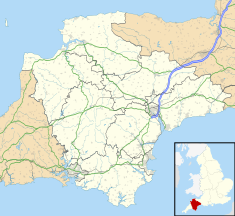
Compton Castle in the parish of Marldon in Devon, is a fortified manor house in the village of Compton, about 5 miles (8 km) west of Torquay on the southern coast of Devon, England. The estate was home to the families of Compton, de la Pole, Doddiscombe, Gilbert and Templer. The castle has been home to the Gilbert family for most of the time since it was built. Listed as a Grade 1 set of buildings, it has been a National Trust property since 1951.

Bickleigh Castle is a fortified manor house that stands on the banks of the River Exe at Bickleigh in Devon, England. Once considerably larger, Bickleigh now comprises a group of buildings from various periods which together formed a water castle.
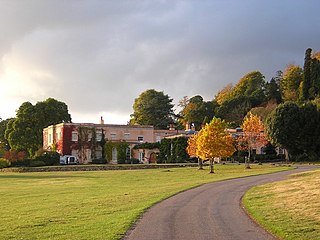
Killerton is an 18th-century house in Broadclyst, Exeter, Devon, England, which, with its hillside garden and estate, has been owned by the National Trust since 1944 and is open to the public. The National Trust displays the house as a comfortable home. On display in the house is a collection of 18th- to 20th-century costumes, originally known as the Paulise de Bush collection, shown in period rooms.
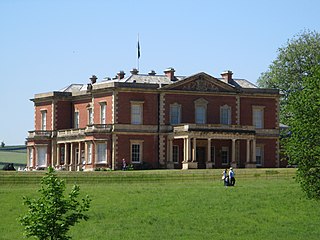
Hillersdon House in the parish of Cullompton in Devon, is a grade II* listed late Georgian style manor house overlooking that town. It was built in 1848 by William Charles Grant (1817-1877), to the design of Samuel Beazley, the notable theatre architect.

Sandford is a village and civil parish in the District of Mid Devon within Devon, England. Sandford is part of the electoral ward named Sandford and Creedy. The ward population at the 2011 Census was 3,429.

Bratton Clovelly is a village, parish and former manor in the west part of Devon, England. It is situated about 8 miles (13 km) south-west of Okehampton immediately north of the A30 road. The manor of Bratton Clovelly was listed in the Domesday Book of 1086. The parish church dedicated to St Mary is 15th-century, with many Norman features. The former village stocks are kept in the belfry. The parish is thought to have been the birthplace of influential 13th-century jurist Henry de Bracton; however, this claim is also made for at least two other places.

Goodleigh is a village, civil parish and former manor in North Devon, England. The village lies about 2+1⁄2 miles (4 km) north-east of the historic centre of Barnstaple. Apart from one adjunct at the south, it is generally a linear settlement.
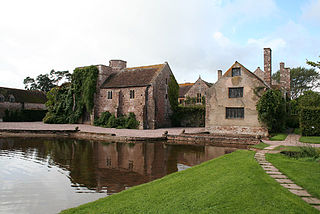
Cothay Manor is a grade one listed medieval house and gardens, in Stawley, near Wellington, Somerset.
Margaret, Lady Hoby née Dakins was an English diarist of the Elizabethan period. Hers is the earliest known diary written by a woman in English. She had a Puritan upbringing. Her diary covering the period 1599–1605 reflects much religious observance, but gives little insight into the writer's private feelings.

Huntsham is a small village and civil parish, formerly a manor and ecclesiastical parish, in the Mid Devon district of Devon, England. The nearest town is Tiverton, about 5.8 miles (9.3 km) south-west of the village. The parish is surrounded clockwise from the north by the parishes of Bampton, Hockworthy, Uplowman and Tiverton; it is bounded on the east by the River Lowman and by a minor road on Bampton Down to the north west, where it reaches a maximum height of 914 feet (279 m). In 2001 the population of the parish was 138, down from 222 in 1901.

Tapeley is a historic estate in the parish of Westleigh in North Devon, England.

Trereife House is a grade II listed manor house located west of the town of Penzance in Cornwall, England, UK. The house was built in the 18th century and has two storeys and a hipped roof with dormer windows. Today the house is open for day visitors and also offers bed and breakfast rooms.

Fowelscombe is a historic manor in the parish of Ugborough in Devon, England. The large ancient manor house known as Fowelscombe House survives only as an ivy-covered "romantic ruin" overgrown by trees and nettles, situated 1 mile south-east of the village of Ugborough. The ruins are a Grade II listed building.
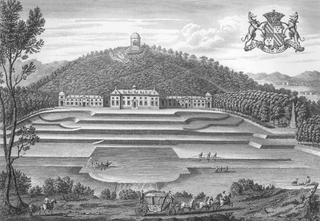
Castle Hill in the parish of Filleigh in North Devon, is an early Palladian country house situated 3 miles north-west of South Molton and 8 mi (13 km) south-east of Barnstaple. It was built in 1730 by Hugh Fortescue, 14th Baron Clinton (1696–1751), who was later created in 1751 1st Baron Fortescue and 1st Earl of Clinton, the son of Hugh Fortescue, lord of the manor of Filleigh, Weare Giffard, etc., whose family is earliest recorded as residing in the 12th century at the manor of Whympston in the parish of Modbury in South Devon. The Fortescue family became major land owners, influential in British and West Country history. Castle Hill is a rare example in Devon of an 18th-century country mansion "on the grand scale".

Roborough is a village and civil parish 5.5 mi (8.9 km) from Great Torrington. Situated topographically on the plateau between the Torridge and Taw Rivers, the parish covers 1,258 ha and contains a population of some 258 parishioners. It is surrounded by a pastoral landscape of rectangular fields, high hedges and scattered farmsteads.

Sydenham House in the parish of Marystow in Devon, England, is a seventeenth-century manor house. The Grade I listed building is situated about thirteen miles south-west of Okehampton, on a 1,200 acres (490 ha) estate. It was built by Sir Thomas Wise (d.1629) between 1600 and 1612, incorporating an older structure. It was partially destroyed by fire in 2012. The gardens are Grade II listed in the National Register of Historic Parks and Gardens.

Duncraig Castle is a mansion in Lochalsh, in the west of the Scottish Highlands. A category-C listed building, it is situated in the Highland council area, east of the village of Plockton on the south shore of Loch Carron. It was built in 1866 in the Scottish baronial style, to designs by Alexander Ross, for Scottish Member of Parliament and businessman Alexander Matheson. The castle remained in the Matheson family until the 1920s, when it was sold to Sir Daniel Hamilton and his wife Margaret, who owned the neighbouring estate. The Hamiltons intended to use the castle for educational purposes in the local community, but this never came to fruition and following the outbreak of World War II, the castle was used as a naval hospital. By the end of the war, Daniel Hamilton had died, and Margaret bequeathed the castle to the local council, which converted it for use as a home economics college for girls, operating in this capacity until its closure in 1989.

Merryfield is a historic estate in the parish of Ilton, near Ilminster in Somerset, England. It was the principal seat of the Wadham family, and was called by Prince their "noble moated seat of Meryfeild" (sic). The mansion house was demolished in 1618 by Sir John Wyndham (1558–1645), of Orchard Wyndham, a nephew and co-heir of Nicholas II Wadham (1531–1609), co-founder of Wadham College, Oxford, the last in the senior male line of the Wadham family. It bears no relation to the present large 19th-century grade II listed mansion known as Merryfield House, formerly the vicarage, immediately south of St Peter's Church, Ilton.

Gittisham is an historic manor largely co-terminous with the parish of Gittisham in Devon, England, within which is situated the village of Gittisham. The capital estate is Combe, on which is situated Combe House, the manor house of Gittisham, a grade I listed Elizabethan building situated 2 1/4 miles south-west of the historic centre of Honiton and 3 1/4 miles north-east of the historic centre of Ottery St Mary.

Sherford is a village and former civil parish and manor, now in the parish of Frogmore and Sherford, in Devon, situated about 2 1/2 miles east of the town of Kingsbridge. It should not be confused with the new town Sherford to be built on the outskirts of Plymouth, about 18 miles to the north-west. The parish church is dedicated to Saint Martin of Tours. In 1961 the parish had a population of 258. The parish was abolished in 1986 and merged with parts of South Pool and Charleton to form "Frogmore and Sherford".

